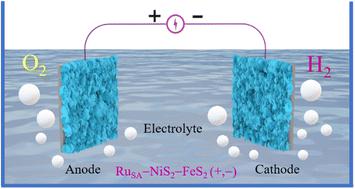当前位置:
X-MOL 学术
›
J. Mater. Chem. A
›
论文详情
Our official English website, www.x-mol.net, welcomes your
feedback! (Note: you will need to create a separate account there.)
Ruthenium single atoms implanted on NiS2-FeS2 nanosheet heterostructures for efficacious water electrolysis
Journal of Materials Chemistry A ( IF 10.7 ) Pub Date : 2024-01-12 , DOI: 10.1039/d3ta05630a Ram Babu Ghising 1 , Uday Narayan Pan 1 , Mani Ram Kandel 1 , Purna Prasad Dhakal 1 , Saleem Sidra 2 , Do Hwan Kim 2 , Nam Hoon Kim 1 , Joong Hee Lee 1, 3
Journal of Materials Chemistry A ( IF 10.7 ) Pub Date : 2024-01-12 , DOI: 10.1039/d3ta05630a Ram Babu Ghising 1 , Uday Narayan Pan 1 , Mani Ram Kandel 1 , Purna Prasad Dhakal 1 , Saleem Sidra 2 , Do Hwan Kim 2 , Nam Hoon Kim 1 , Joong Hee Lee 1, 3
Affiliation

|
The catalytic potential of single atom incorporated heterostructures holds substantial promise because of their ability to offer customizable chemical functionality and abundant active sites. In this study, a novel approach is employed to synthesize ruthenium single atoms (RuSA) implanted on bimetallic NiFe-LDH derived sulfide nanosheet heterostructures (RuSA-NiS2-FeS2) via a facile technique. Experimental findings demonstrate that RuSA-NiS2-FeS2 exhibits lower overpotential (η) for water splitting. Specifically, the hydrogen evolution reaction (HER) overpotentials at current densities of (10 and 100) mA cm−2 are measured to be (57 and 187) mV, respectively. Similarly, at (20 and 100) mA cm−2, the oxygen evolution reaction (OER) overpotentials are recorded to be (242 and 304) mV, respectively. Conspicuously, the RuSA-NiS2-FeS2 (+, −) electrolyzer requires cell potentials of (1.47 and 1.74) V at (10 and 100) mA cm−2, lower than the cell potentials of (1.57 and 1.92) V required by the RuO2@NF (+)//Pt–C@NF (−) device to achieve similar current densities. These experimental results and the Density Functional Theory (DFT) calculations unveil that our research offers a promising method for single atom implanted heterostructures that can be used for large-scale clean hydrogen production through water electrolysis.
中文翻译:

将钌单原子植入 NiS2-FeS2 纳米片异质结构以实现有效的水电解
单原子异质结构的催化潜力具有巨大的前景,因为它们能够提供可定制的化学功能和丰富的活性位点。在本研究中,采用一种新方法通过简便的技术合成植入双金属NiFe-LDH衍生的硫化物纳米片异质结构(Ru SA -NiS 2 -FeS 2)上的钌单原子(Ru SA )。实验结果表明Ru SA -NiS 2 -FeS 2表现出较低的水分解过电势( η )。具体地,测得电流密度为(10和100)mA cm -2下的析氢反应(HER)过电势分别为(57和187)mV。类似地,在(20和100)mA cm -2下,析氧反应(OER)过电势分别记录为(242和304)mV。值得注意的是,Ru SA -NiS 2 -FeS 2 (+, -) 电解槽在(10和100)mA cm -2时需要(1.47和1.74)V的电池电势,低于(1.57和1.92)V的电池电势RuO 2 @NF (+)//Pt–C@NF (−) 器件需要达到相似的电流密度。这些实验结果和密度泛函理论(DFT)计算表明,我们的研究为单原子注入异质结构提供了一种有前景的方法,可用于通过水电解大规模生产清洁氢气。
更新日期:2024-01-14
中文翻译:

将钌单原子植入 NiS2-FeS2 纳米片异质结构以实现有效的水电解
单原子异质结构的催化潜力具有巨大的前景,因为它们能够提供可定制的化学功能和丰富的活性位点。在本研究中,采用一种新方法通过简便的技术合成植入双金属NiFe-LDH衍生的硫化物纳米片异质结构(Ru SA -NiS 2 -FeS 2)上的钌单原子(Ru SA )。实验结果表明Ru SA -NiS 2 -FeS 2表现出较低的水分解过电势( η )。具体地,测得电流密度为(10和100)mA cm -2下的析氢反应(HER)过电势分别为(57和187)mV。类似地,在(20和100)mA cm -2下,析氧反应(OER)过电势分别记录为(242和304)mV。值得注意的是,Ru SA -NiS 2 -FeS 2 (+, -) 电解槽在(10和100)mA cm -2时需要(1.47和1.74)V的电池电势,低于(1.57和1.92)V的电池电势RuO 2 @NF (+)//Pt–C@NF (−) 器件需要达到相似的电流密度。这些实验结果和密度泛函理论(DFT)计算表明,我们的研究为单原子注入异质结构提供了一种有前景的方法,可用于通过水电解大规模生产清洁氢气。











































 京公网安备 11010802027423号
京公网安备 11010802027423号